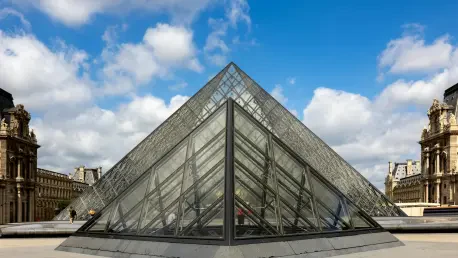The art world stands in shock following a daring heist at the Louvre Museum in Paris, where historic royal jewels worth an estimated €88 million ($102 million), including tiaras and earrings once belonging to Queen Marie-Amélie and Queen Hortense, were stolen in a meticulously executed theft. This audacious crime has not only sent ripples through the global cultural community but has also reignited a long-standing and complex debate about the feasibility and ethics of insuring artifacts deemed priceless due to their profound historical and cultural significance. The incident at one of the most renowned museums in the world serves as a sobering reminder of the vulnerabilities that national treasures face in an era of increasingly sophisticated criminal operations. It raises critical questions about how such irreplaceable items can be protected and whether traditional insurance models can ever truly account for their value. This event compels a deeper examination of the systemic challenges in safeguarding cultural heritage against theft and loss.
Unraveling the Valuation Conundrum
The heart of the debate sparked by the Louvre heist lies in the nearly impossible task of placing a monetary value on artifacts that embody national identity and historical turning points. Items like the stolen Napoleonic crown jewels defy standard market comparisons, unlike contemporary artworks that benefit from recent auction records to guide their worth. Without comparable data, insurers struggle to apply conventional models, rendering private coverage for such treasures nearly unfeasible. Petra Warrington, an expert from Wedlake Bell, points out that the cultural magnitude of these pieces creates risks so vast that private insurers are often unwilling to underwrite them. Consequently, many of the world’s most significant artifacts, including those housed at the Louvre, remain without private insurance, exposing a fundamental gap in how cultural heritage is financially protected against loss or theft in today’s landscape.
This valuation challenge extends beyond mere numbers to the very essence of what these artifacts represent to humanity. Even if a price tag could somehow be assigned, it would fail to capture the intangible worth tied to centuries of history and collective memory. The absence of a reliable framework for assessing such value means that institutions must grapple with the reality that no payout could ever replace what is lost. This dilemma has led to a broader discussion within the art community about whether financial mechanisms are even the right approach for safeguarding items of unparalleled significance. The Louvre incident underscores the urgency of finding alternative strategies that prioritize prevention over compensation, as the cultural void left by such thefts cannot be filled by any amount of money. It also highlights the need for international dialogue on standardizing approaches to protect these treasures from disappearing into the shadows of the black market.
State Practices in Risk Management
A significant aspect of the insurance debate centers on the differing approaches between state-owned institutions and private collections when it comes to protecting high-value artifacts. National museums like the Louvre often operate under a model of self-insurance, managed through governmental bodies such as France’s Ministry of Culture, rather than seeking commercial policies. This practice reflects a deep-seated belief that financial compensation falls short of addressing the cultural devastation caused by the loss of such items. The theft of the royal jewels has amplified this perspective, with many in the art world mourning not just a monetary hit but a profound wound to global heritage. State self-insurance, while symbolically acknowledging the irreplaceable nature of these treasures, often leaves institutions bearing the full brunt of risk without external safety nets.
In contrast, private entities and foundations frequently secure robust commercial insurance backed by global reinsurers to mitigate potential losses. This disparity reveals a structural divide in how cultural assets are protected based on ownership. For state-run museums, the reliance on self-insurance can strain resources, especially when recovery or security upgrades are needed post-theft. The Louvre heist has prompted renewed scrutiny of whether this model is sustainable in an age of escalating threats. Some argue that partnerships with private insurers could supplement state efforts, though the challenge of valuation persists as a barrier. As discussions unfold, the incident serves as a catalyst for reevaluating how governments allocate funds and prioritize the safeguarding of national treasures, potentially paving the way for hybrid models that balance cultural ethos with practical risk management.
Scrutinizing Security Shortfalls
The brazen theft at the Louvre has thrust museum security measures into the spotlight, revealing potential weaknesses in even the most prestigious institutions. Despite reported enhancements to display cases several years ago, critics have pointed to outdated infrastructure as a contributing factor in the heist, raising serious concerns about the adequacy of current protective systems. Lenders of high-value artifacts often stipulate rigorous security protocols, such as continuous surveillance and dedicated personnel, in loan agreements, with noncompliance risking legal consequences. The failure to prevent this theft has intensified calls for modernization, pushing cultural institutions to invest in cutting-edge technology to deter increasingly sophisticated criminals who exploit any lapse in vigilance.
Beyond immediate upgrades, the incident has broader implications for how security standards are set and enforced across the globe. Museums now face mounting pressure to not only enhance physical protections but also to align with stricter underwriting guidelines if seeking private insurance or indemnity protection. The fallout from the Louvre heist suggests that lapses in security can have cascading effects, from damaging institutional reputation to complicating future loan arrangements. This situation underscores the interconnectedness of robust security and financial risk management, as insurers may become more hesitant to cover institutions perceived as vulnerable. As a result, the art world is likely to see a shift toward more stringent global benchmarks, compelling museums to prioritize investment in prevention over reaction to ensure the safety of their collections.
Learning from Historical Thefts
To fully grasp the significance of the Louvre heist, it is essential to place it within the broader context of past cultural thefts that have challenged the art world for decades. Notable cases, such as the 1990 heist at the Isabella Stewart Gardner Museum, where artworks valued at over $500 million remain unrecovered, and the 1911 theft of the Mona Lisa, which was fortunately returned, illustrate a persistent vulnerability in safeguarding high-value items. These incidents reveal a troubling pattern: while some stolen treasures are eventually retrieved through diligent efforts, many vanish into obscurity, often absorbed into illicit markets. This historical perspective emphasizes that the Louvre theft is not an isolated event but part of a recurring struggle to protect cultural assets from determined thieves.
Reflecting on these past events also highlights the varying outcomes of recovery efforts and the lessons they offer for current challenges. The successful return of the Mona Lisa demonstrated the value of international cooperation and public awareness, whereas the ongoing mystery of the Gardner Museum theft serves as a grim reminder of the limits of recovery when trails go cold. The Louvre incident prompts a reexamination of strategies employed in response to such crimes, from leveraging advanced tracking technologies to fostering global networks for information sharing. These historical examples underscore the urgency of preemptive measures over reactive ones, as the emotional and cultural toll of losing such artifacts often overshadows any hope of restitution. They also call for a collective commitment to fortify defenses against future thefts, ensuring history does not repeat itself.
The Deeper Cultural Impact
The emotional and cultural ramifications of losing artifacts like the Louvre’s royal jewels extend far beyond any financial calculation, striking at the core of shared human heritage. Experts and institutions alike agree that the true cost of such thefts lies in the erosion of collective identity and historical continuity, aspects that no monetary compensation can restore. This profound sense of loss felt across the global art community after the heist reinforces why many national treasures remain uninsured by private entities. The consensus holds that these items are not mere objects but embodiments of a society’s past, meant to educate and inspire future generations. Their disappearance creates a void in cultural narratives that cannot be quantified or replaced.
This perspective challenges the very notion of insurance as a solution for priceless artifacts, pushing the conversation toward prevention and preservation over financial redress. The Louvre heist has amplified discussions on how societies value and protect their cultural legacies, prompting calls for increased public and governmental support for museums. It also raises ethical questions about the role of private markets in handling items of universal significance, as the focus shifts to safeguarding rather than compensating. As the art world grapples with this loss, there is a growing recognition that international collaboration and innovative approaches—beyond traditional insurance—are critical to ensuring that such treasures endure as testaments to human history, rather than becoming casualties of theft and neglect.
Shaping Future Protections
Looking back, the audacious theft at the Louvre marked a pivotal moment that forced the art world to confront the limitations of insuring irreplaceable cultural treasures. It exposed the inadequacy of financial mechanisms to address the profound cultural losses incurred and highlighted glaring gaps in security infrastructure at even the most iconic institutions. The incident served as a wake-up call, revealing that the true value of artifacts lies not in monetary terms but in their role as custodians of history and identity. Moving forward, the focus must shift toward actionable solutions, such as fostering global partnerships to enhance security protocols and investing in advanced technologies to deter theft. Additionally, exploring hybrid models that blend state self-insurance with private support could offer a balanced approach to risk management. Ultimately, this event underscored the need for a unified commitment to prioritize preservation, ensuring that cultural heritage remains secure for future generations to cherish and learn from.









